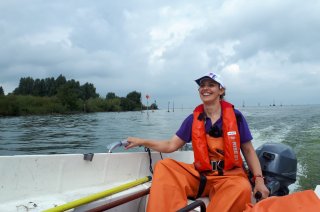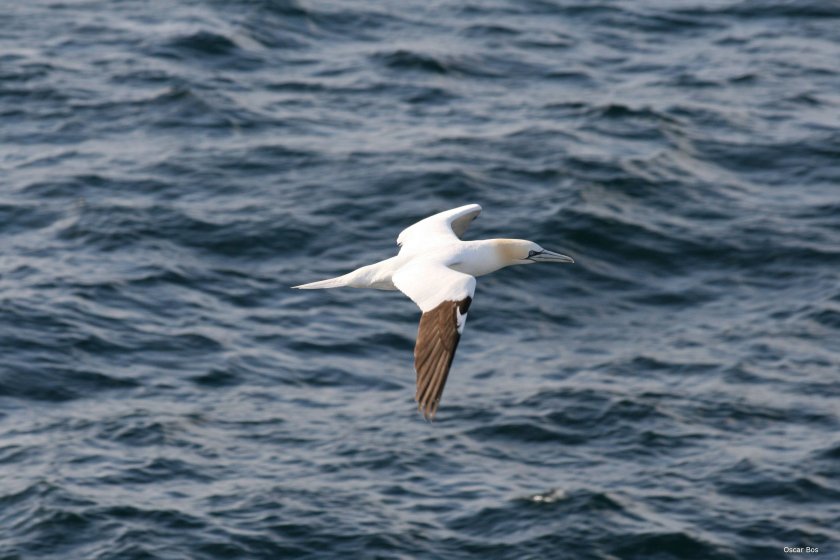
Interview
Loss of bird habitat: a complex ecological puzzle
Wind farms on land are known to pose a danger to birds. But what about offshore wind? Floor Soudijn makes computer models that aim to answer that question. The issue is more complicated than you might think, but there are some important insights that Soudijn is able to share.
From a bird’s perspective, wind turbines are potentially life-threatening. The tips of the blades reach speeds of more than 200 kilometers per hour. “Observations of birds falling victim to offshore wind turbines are extremely rare”, says Floor Soudijn, theoretical biologist at Wageningen Marine Research. “But that’s also because it’s very unlikely that you’ll ever find these victims. You’d actually have to observe a collision to be sure that it happened.”
It is not just collisions that present a danger for birds. Offshore wind may also have indirect negative effects. “Birds may avoid the wind farms”, says Soudijn, “which effectively translates into habitat loss. A reduction of the foraging area may affect reproduction or survival.”
Birds may avoid the wind farms, which effectively translates into habitat loss.
Fieldwork and models
Colleagues are doing fieldwork to shed light on these phenomena. Direct observations and research with radio transmitters show the presence of birds within or outside the parks at certain times. And research on banded birds and their nests provides information about annual survival and breeding success.
“On the basis of all these data, we are creating computer models that allow us to calculate what the loss of habitat actually means for bird populations”, says Soudijn. “This work is part of a programme that started in 2014. In addition, I am working on a smaller project, which is nearing completion, and which focuses on the probability of a bird being hit if it flies within range of a turbine.”
Habituation
In both cases, it’s too early to predict the outcomes, says Soudijn. Also, the concept of habitat loss should be approached with some caution, she adds: at the moment, offshore wind is taking up a relatively limited surface area. “For the time being, the impact of habitat loss on bird populations seems to be limited”, says Soudijn. “But ultimately, if an increasing part of the North Sea is used for wind energy production, there could indeed be a significant impact.”
In addition, the question remains how individual birds will react to larger-scale offshore wind farms. “Maybe there will be habituation”, Soudijn remarks. “And perhaps in the future companies will prefer the much larger wind turbines, which are spaced further apart. Perhaps birds will be able to fly in between them much more easily. Or they migh actually more negatively affected by larger turbines.”

Scenarios
If so many aspects are still uncertain, is there actually much use in such theoretical research? “Certainly”, says Soudijn, “because it allows us to elaborate all kinds of possible scenarios. Even if we don’t exactly know the absolute impact yet, those calculations do provide insight into how scenarios relate to each other. This helps policy makers decide on new search locations for wind farms – even today.”
Piece by piece, we hope to be able to complete the puzzle.
In addition, the models make clear which additional research is needed to make better predictions. “Perhaps we need more insight into where the prey of certain species is located. And do we know enough about the sediment, water depth and the clarity of the seawater?”
Piece together the puzzle
In the meantime, technologies are developed that decrease bird mortality in wind farms. On land, for example, there are experimental camera detection systems that bring turbines to a halt as soon as a bird approaches. In addition, Norwegian research has shown that painting one of the blades black can significantly reduce bird mortality.
“Within Wageningen Marine Research, we are also making integrated models that address impacts on different animal groups”, concludes Soudijn. “Suppose, for example, that marine mammals find refuge in wind farms, because there is no fishing – what does that mean for the birds? And if fisheries are moved elsewhere, how does that affect the benthic animals, and the fish, and thereby the birds?”
Wageningen Marine Research addresses these questions in the context of the Offshore Wind Ecological Programme (Wozep), in cooperation with other institutions, including Deltares and Bureau Waardenburg. Soudijn: “Ultimately, we aim to develop multidisciplinary models that also take into account other biological factors and the physical environment.”
Much is still unclear, the researcher concludes. “It’s a complex ecological story. But piece by piece, we hope to be able to complete the puzzle. Other than that, it is a matter of patience. But I guess that’s the nature of science.”